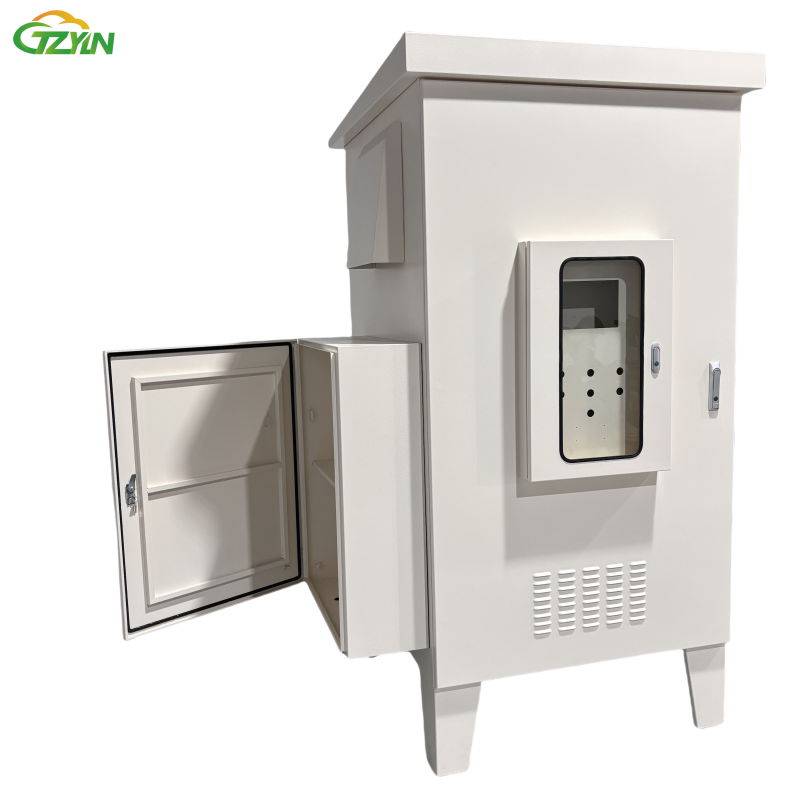The Critical Role of Frequency Conversion Cabinets in Motor Systems
Frequency conversion cabinets are vital for controlling the speed and torque of electric motors, making them indispensable in various industrial applications. They optimize motor performance by enabling precise manipulation of motor speeds, which is crucial for industries relying on machinery like manufacturing and production lines. For instance, adjusting motor speeds ensures optimal output while safeguarding equipment from excessive wear and tear.
These cabinets facilitate the transformation of standard electrical feed into variable frequencies, allowing for precise motor control and operational efficiency. By regulating the frequency and voltage of electrical power, they ensure that motors operate at optimal levels, reducing energy wastage and lowering electricity consumption. In essence, frequency conversion cabinets serve as the backbone of modern motor systems, driving efficiency and reliability across various applications.
Motor Speed Control Mechanisms in Frequency Conversion Systems
To effectively control motor speed in frequency conversion systems, understanding the various mechanisms at play is essential. These control methods not only enhance operational efficiency but also contribute to the longevity and performance of motor systems. The intricate interplay between these mechanisms ensures that motors operate smoothly and efficiently under varying load conditions.
Variable Frequency Drives: Core of Speed Regulation
Variable Frequency Drives (VFDs) form the bedrock of motor speed regulation, offering substantial energy savings across industrial processes. By varying the frequency and voltage supplied to electric motors, VFDs enable precise speed control, thus curbing unnecessary energy consumption. This technology allows for smooth acceleration and deceleration, reducing the wear and tear on machinery while also preventing abrupt energy spikes. VFDs are indispensable in industries requiring consistent motor performance, such as manufacturing and HVAC systems, due to their ability to modulate motor speed to meet varying process demands.
Soft-Start Capabilities for Reduced Mechanical Stress
Soft-start capabilities in frequency conversion cabinets are pivotal for minimizing mechanical stress on motors, thereby extending their operational lifespan. This feature incrementally ramps up voltage and current during startup, which assures smoother motor initiation and curtails sudden, jarring movements that could damage mechanical components. The soft-start mechanism is particularly beneficial in applications where motors are frequently started and stopped, as it effectively reduces the mechanical burden on the motor, leading to a longer life cycle and lower maintenance costs.
Torque Optimization Through Frequency Adjustment
Torque optimization is another critical function facilitated by frequency adjustment in motor systems. By tweaking the frequency supplied to the motor, these systems can maintain desired torque levels, enhancing performance across varying loads. This adjustment is crucial for efficiency, as it ensures that the motors do not draw excessive power, thereby minimizing energy losses. Effective torque management not only boosts energy efficiency but also improves the overall functionality of machinery, ensuring reliability and stability in operations ranging from heavy-duty manufacturing equipment to delicate processing lines.
Energy Efficiency Breakthroughs with Frequency Conversion Technology
Reducing Energy Consumption Patterns
Frequency conversion technology revolutionizes energy consumption patterns by significantly reducing the energy needed in applications with variable loads and operations. This innovative approach ensures that motor-driven systems operate more efficiently, leading to substantial savings. For instance, studies indicate that employing Variable Frequency Drives (VFDs)—the cornerstone of frequency conversion—can cut energy usage by 20-50%. This is achieved by tailoring motor speeds to actual performance requirements, which minimizes unnecessary power usage and optimizes overall system efficiency.
Demand-Based Power Delivery Systems
Demand-based power delivery systems represent a strategic advancement in optimizing energy use. These systems enable utilities and businesses to match energy supply precisely to real-time consumption needs, reflecting a paradigm shift in energy management. The flexibility offered by demand-based systems ensures that energy is delivered efficiently, aligning with actual consumption patterns. This alignment not only enhances the efficiency of the power grid but also supports economic savings by preventing surplus energy generation and distribution.
Harmonic Suppression for Improved Power Quality
Incorporating harmonic suppression techniques within frequency conversion systems substantially improves power quality. The suppression of harmonics—a common issue in electrical systems—leads to smoother operation, reducing wear on components and wasting less energy. Enhanced power quality from harmonic suppression not only fosters operational efficiency but also diminishes the likelihood of equipment malfunction and prolongs device longevity. By pursuing a strategy that reduces energy waste, industries can achieve both financial savings and improved sustainability.
Performance Enhancement Through Intelligent Frequency Adaptation
Dynamic Load Handling Capabilities
Intelligent frequency adaptation is crucial for handling dynamic loads efficiently, ensuring systems maintain optimal performance during fluctuations. This technology is indispensable in industries where production demands are varied and unpredictable, such as manufacturing and energy sectors. For instance, GE Vernova's Power Conversion systems exemplify dynamic power management capabilities by automatically reconfiguring to meet the specific power needs of ships docked at ports. This adaptability not only enhances system reliability but also minimizes disruptions.
Precision Control for Complex Operations
Precision control offered by frequency conversion technology allows motors to perform complex operations with high accuracy, which is vital in high-stakes industries. Incorporating systems like GE Vernova's ensures a meticulous execution of tasks without compromising quality, significantly boosting productivity. This level of control minimizes errors and reduces the need for rework, translating into substantial operational efficiencies and cost savings.
Thermal Management Strategies
Effective thermal management strategies within frequency conversion systems mitigate overheating risks and bolster reliability. Integrating advanced cooling methods, akin to GE Vernova's air-cooling systems for heat dissipation in static frequency converters, is essential for sustaining optimal performance amidst diverse operational conditions. These strategies are pivotal in maintaining the integrity of the system, thereby increasing its lifespan and efficiency in various applications.
Cost Reduction Strategies Enabled by Frequency Conversion
Reducing Maintenance Frequency Through Optimized Operation
Optimized operation through frequency conversion substantially decreases maintenance frequency, leading to both time and financial savings. By ensuring equipment operates under optimal conditions, frequency conversion minimizes mechanical stress, thereby reducing the need for frequent interventions. As a result, businesses benefit from increased uptime, which translates into higher productivity and efficiency. This aspect is critical in industries where operational delays can lead to significant profit losses.
Extended Equipment Lifespan Calculations
Frequency conversion technologies contribute to an extended lifespan of equipment, an advantage that is quantifiable through lifecycle cost analyses. These analyses illustrate how investing in frequency conversion systems results in lower overall costs compared to traditional systems. The reduction in mechanical wear and energy efficiency are primary factors that enhance equipment longevity. Over time, the initial costs of implementing these technologies are offset by the savings accrued from reduced repair and replacement expenses, reinforcing their value in a competitive industrial landscape.
Operational Cost-Benefit Analysis
Undertaking a detailed operational cost-benefit analysis provides a comprehensive view of the economic advantages of frequency conversion cabinets. This analysis shows that while the upfront investment may appear significant, it is outweighed by long-term savings achieved through enhanced performance and reduced energy bills. The ability to lower operational costs through precise energy management and minimized mechanical wear justifies the initial expenditure. Businesses leverage these quantifiable benefits to achieve financial efficiency and sustainability in power operations, underscoring the importance of integrating frequency conversion cabinets in modern power systems.
FAQ
What is the main benefit of using frequency conversion cabinets in motor systems?
Frequency conversion cabinets are essential for controlling motor speed and optimizing performance, resulting in enhanced energy efficiency and reduced mechanical stress, which prolongs equipment lifespan and reduces operational costs.
How do Variable Frequency Drives (VFDs) contribute to energy savings?
VFDs adjust the frequency and voltage supplied to electric motors, allowing for precise speed control and reducing unnecessary energy consumption. This leads to smoother operation and significant energy savings, particularly in industries with variable load demands.
What role does soft-start capability play in frequency conversion systems?
Soft-start capability gradually ramps up voltage and current during motor startup, reducing mechanical stress and preventing sudden movements that could damage components. This feature extends motor lifespan and decreases the need for frequent maintenance.
Table of Contents
- The Critical Role of Frequency Conversion Cabinets in Motor Systems
- Motor Speed Control Mechanisms in Frequency Conversion Systems
- Energy Efficiency Breakthroughs with Frequency Conversion Technology
- Performance Enhancement Through Intelligent Frequency Adaptation
- Cost Reduction Strategies Enabled by Frequency Conversion
- FAQ




